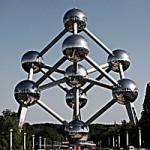In a favorite scene from a favorite movie (Stranger than Fiction, 2006, trailer below), Dustin Hoffman describes the consequence of dramatic structure to Will Ferrell: “In a tragedy, you die. In a comedy, you get hitched.” Ferrell plays Harold Crick, an IRS agent who starts hearing his life being narrated by a British woman’s voice (Emma Thompson). Hoffman, as a literature professor, suggests that Crick find out which dramatic structure he’s in — tragedy or comedy — to determine his likely fate.
For Harold Crick, structure is more than academic theory or dispassionate analysis. Structure will determine his path to either a wedding bash or a funeral.
While the situation may not be quite so absolute for cultural organizations and their managers, structure does matter — to their health, their future, and their ability to adapt. So, it’s a wise manager who explores the structures he or she is working in.
Rather than structures of comedy or tragedy (although, of course those), cultural managers face a range of structures from financial to physical to organizational to political. They inherit them when they join an organization, and they build and adjust them through their choices and actions with their colleagues and boards. The construction and consequence of these structures has become a growing part of my teaching, research, and service in the field.
“Structure,” of course, is a tricky word that can mean many things. In my work, I’ve adopted the definition of structure as “any durable system of relationships between constituent parts of an identifiable whole.” It has parts, those parts have some durable configuration or relationship with each other (how durable is a larger question), and the parts together in that relationship constitute an identifiable whole.
Walls, rooms, doors, roofing, beams, mechanical systems, and other elements can be arranged into a physical structure we call a building. Cash, debt, designated funds, endowments, and economic assets come together in a capital structure we can observe on a balance sheet. People, jobs, reporting relationships, and hierarchies combine into an organizational structure we can discover or discern through formal charts or informal exploration.
And while these structures may not determine our fate, they certainly influence it. Physical structures inform how you move and how you feel. Capital structures inform how you spend and how you assess risk. Organizational structures inform how you learn, behave, and adapt as a collective.
Harold Crick spends a large portion of the movie wondering whether he’s a player or a pawn in the structures around him. Cultural managers have a ready answer to the question: They are both.


